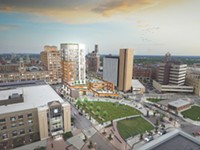Thursday, February 13, 2014
Perception of city crime, police performance varies depending on who you are and where you live
Posted By Christine Carrie Fien on Thu, Feb 13, 2014 at 4:59 PM
A survey of 383 Rochester residents conducted late last year found that there is a deep divide between the perception and reality of crime in the city (the full survey can be found below). And the gap widens or narrows depending on the race, age, and income of the respondents, as well as the area of the city in which they live and whether they rent or own their homes.
Cornell University conducted the survey last November and December, and the results were released at a press conference today by Rochester interim Police Chief Michael Ciminelli. Ciminelli was joined by Mayor Lovely Warren and City Council President Loretta Scott.
Violent crime in the City of Rochester is down significantly overall, Ciminelli said, but the perception of many city residents doesn't match that reality. Ciminelli and Warren were reluctant to say what is driving that perception. But it's clear, they said, that having positive interactions with the police department improves people's perception of public safety in the city overall.
Some highlights of the survey report:
• 93 percent of respondents said they feel safe in their neighborhood during the day;
• About 66 percent said they feel safe in their neighborhood after dark;
• 28.3 percent said they have "a lot of fear" about becoming a victim in areas of the city outside their neighborhood;
• 21 percent feel less safe in their neighborhood compared to a year ago;
• 39.5 percent of people living in the northeast quadrant reported feeling that the overall level of crime in their neighborhood has increased;
• 36.5 percent of nonwhites were most likely to rate police response times as poor or very poor;
Warren and Ciminelli said that the survey results support the decision to move to a quadrant policing model. The city is moving from two stations to four or five in a year or two. Ciminelli said he hopes to have recommendations to Warren in May, and that the new model would be phased in.
But, he said, the RPD would step up its community engagement efforts in the meantime to try to turn some of the perceptions contained in the report around.
Building trust between the police and the community has been a longstanding but elusive goal for the city. More trust would likely mean more cooperation from the community to solve crimes, and would probably improve the overall impression people have of the City of Rochester.
But the disconnect between the police and some residents is more than a perception problem— something the report does not address. There are real issues underpinning the fracture: the inability to effectively target well-known open-air drug markets; the fact that the RPD is a relatively young force — younger officers tend to be more aggressive and less flexible; and the tendency to put rookies in specialized assignments, which, the police union says, deprives them of the seasoning they'd get if they started out working a general beat.
Cornell University conducted the survey last November and December, and the results were released at a press conference today by Rochester interim Police Chief Michael Ciminelli. Ciminelli was joined by Mayor Lovely Warren and City Council President Loretta Scott.
Violent crime in the City of Rochester is down significantly overall, Ciminelli said, but the perception of many city residents doesn't match that reality. Ciminelli and Warren were reluctant to say what is driving that perception. But it's clear, they said, that having positive interactions with the police department improves people's perception of public safety in the city overall.
Some highlights of the survey report:
• 93 percent of respondents said they feel safe in their neighborhood during the day;
• About 66 percent said they feel safe in their neighborhood after dark;
• 28.3 percent said they have "a lot of fear" about becoming a victim in areas of the city outside their neighborhood;
• 21 percent feel less safe in their neighborhood compared to a year ago;
• 39.5 percent of people living in the northeast quadrant reported feeling that the overall level of crime in their neighborhood has increased;
• 36.5 percent of nonwhites were most likely to rate police response times as poor or very poor;
Warren and Ciminelli said that the survey results support the decision to move to a quadrant policing model. The city is moving from two stations to four or five in a year or two. Ciminelli said he hopes to have recommendations to Warren in May, and that the new model would be phased in.
But, he said, the RPD would step up its community engagement efforts in the meantime to try to turn some of the perceptions contained in the report around.
Building trust between the police and the community has been a longstanding but elusive goal for the city. More trust would likely mean more cooperation from the community to solve crimes, and would probably improve the overall impression people have of the City of Rochester.
But the disconnect between the police and some residents is more than a perception problem— something the report does not address. There are real issues underpinning the fracture: the inability to effectively target well-known open-air drug markets; the fact that the RPD is a relatively young force — younger officers tend to be more aggressive and less flexible; and the tendency to put rookies in specialized assignments, which, the police union says, deprives them of the seasoning they'd get if they started out working a general beat.
Police Community Survey 2013-2014
Latest in News Blog
More by Christine Carrie Fien
-

Building up
Mar 29, 2017 -

Hetsko's heart
Mar 15, 2017 -

Squeezing starts at GateHouse-owned Daily Record and RBJ
Feb 28, 2017 - More »

